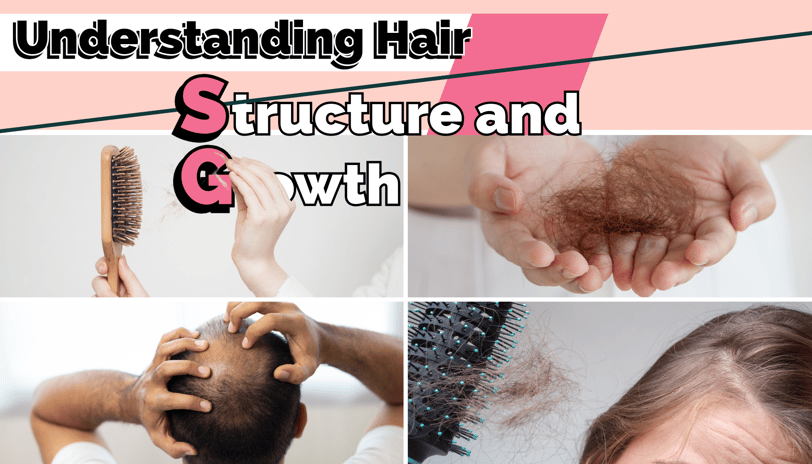Understanding Hair Structure and Growth
Learn about hair structure and the hair growth cycle. Discover how hair follicles, keratin, and the three phases of hair growth impact whether your hair will grow back.
ENGLISHARTICALSHEALTH & PERSONAL


Understanding Hair Structure and Growth
To understand whether your hair will grow back, it's essential to know how hair grows and what it is made of.
Hair Structure
Hair is composed primarily of keratin, a protein produced by hair follicles located within the skin. Each hair strand consists of three layers:
Cuticle: The outer protective layer.
Cortex: The middle layer containing melanin, which determines hair color.
Medulla: The innermost layer, present only in thicker hair.
Hair Growth Cycle
Hair grows in a natural cycle consisting of three phases:
Anagen (Growth Phase): Lasts 2-7 years; active hair growth occurs.
Catagen (Transition Phase): Lasts 2-3 weeks; hair stops growing and detaches from the blood supply.
Telogen (Resting Phase): Lasts about 3 months; hair sheds and is replaced by new growth.
If the hair follicle remains intact after a burn, new hair can regrow. However, if the follicle is severely damaged, regrowth may be compromised.
Types of Burns and Hair Regrowth Potential
The extent of hair regrowth largely depends on the type and severity of the burn.
1. Superficial Burns (First-Degree Burns)
Affects only the outermost layer of the skin (epidermis).
Symptoms: Redness, mild pain, no blistering.
Hair Regrowth: Highly likely, as the hair follicle remains intact.
2. Partial Thickness Burns (Second-Degree Burns)
Affects both the epidermis and part of the dermis.
Symptoms: Blisters, pain, swelling, and skin peeling.
Hair Regrowth: Possible but may take longer. If the follicle is mildly damaged, hair can regrow.
3. Full Thickness Burns (Third-Degree Burns)
Destroys both the epidermis and dermis and may affect underlying tissues.
Symptoms: White or charred skin, loss of sensation due to nerve damage.
Hair Regrowth: Unlikely without medical intervention, as follicles may be permanently destroyed.
Factors Affecting Hair Regrowth After Burning
Severity of the Burn:
Deeper burns that affect the dermis and hair follicles reduce the chance of regrowth.
Extent of Scalp Damage:
Smaller burns have a better recovery rate than extensive burns.
Prompt Treatment:
Immediate care can prevent further damage and promote healing.
Individual Healing Capacity:
Genetics, age, and overall health play a role in how well the skin heals.
Medical Treatments for Hair Regrowth After Burns
If your scalp was affected by burns, medical treatments can aid in promoting hair regrowth:
1. Topical Treatments
Minoxidil (Rogaine): Stimulates hair follicles and can promote hair regrowth.
Aloe Vera: Known for its soothing properties and may help reduce inflammation.
2. Platelet-Rich Plasma (PRP) Therapy
PRP involves injecting plasma from your blood into the scalp to stimulate hair growth and healing.
3. Laser Therapy
Low-level laser therapy can help improve blood circulation and promote regrowth.
4. Hair Transplant Surgery
If follicles are permanently damaged, a hair transplant may be necessary, where healthy follicles are relocated from other parts of the scalp.
Natural Remedies to Support Hair Regrowth
While medical treatments are effective, natural remedies can also support healing and regrowth:
1. Aloe Vera Gel
Reduces inflammation and promotes skin healing.
2. Coconut Oil
Contains fatty acids that nourish the scalp and promote hair growth.
3. Onion Juice
Known for its sulfur content, which helps regenerate hair follicles.
4. Vitamin E Oil
An antioxidant that helps repair damaged scalp tissue.
How to Care for Burned Hair and Scalp
Avoid Harsh Chemicals:
Avoid coloring, perming, or chemically treating your hair after a burn.
Use Gentle Hair Products:
Opt for mild, sulfate-free shampoos.
Protect Your Scalp:
Wear a hat or scarf to protect from sun exposure.
Stay Hydrated and Eat Well:
Foods rich in vitamins (A, C, E) and proteins support skin and hair health.
Emotional Impact of Hair Loss
Losing hair due to burns can be emotionally challenging. Here are some tips for coping:
Seek Support: Consider joining support groups for burn survivors.
Therapy: Counseling can help manage emotional distress.
Cosmetic Options: Wigs and hairpieces can be temporary solutions during the regrowth period.
Conclusion: Will Your Hair Grow Back?
Whether your hair grows back after a burn depends on the severity of the burn and the damage to the hair follicles. If the burn was superficial or mild, hair regrowth is highly likely within a few months. However, deeper burns may require medical treatments or surgical options for hair restoration.
If you're unsure about the severity of your burn, consulting a healthcare professional can provide personalized guidance and treatment options. Stay positive—advances in medical treatments and natural remedies offer hope for hair regrowth after burns. 🌿

